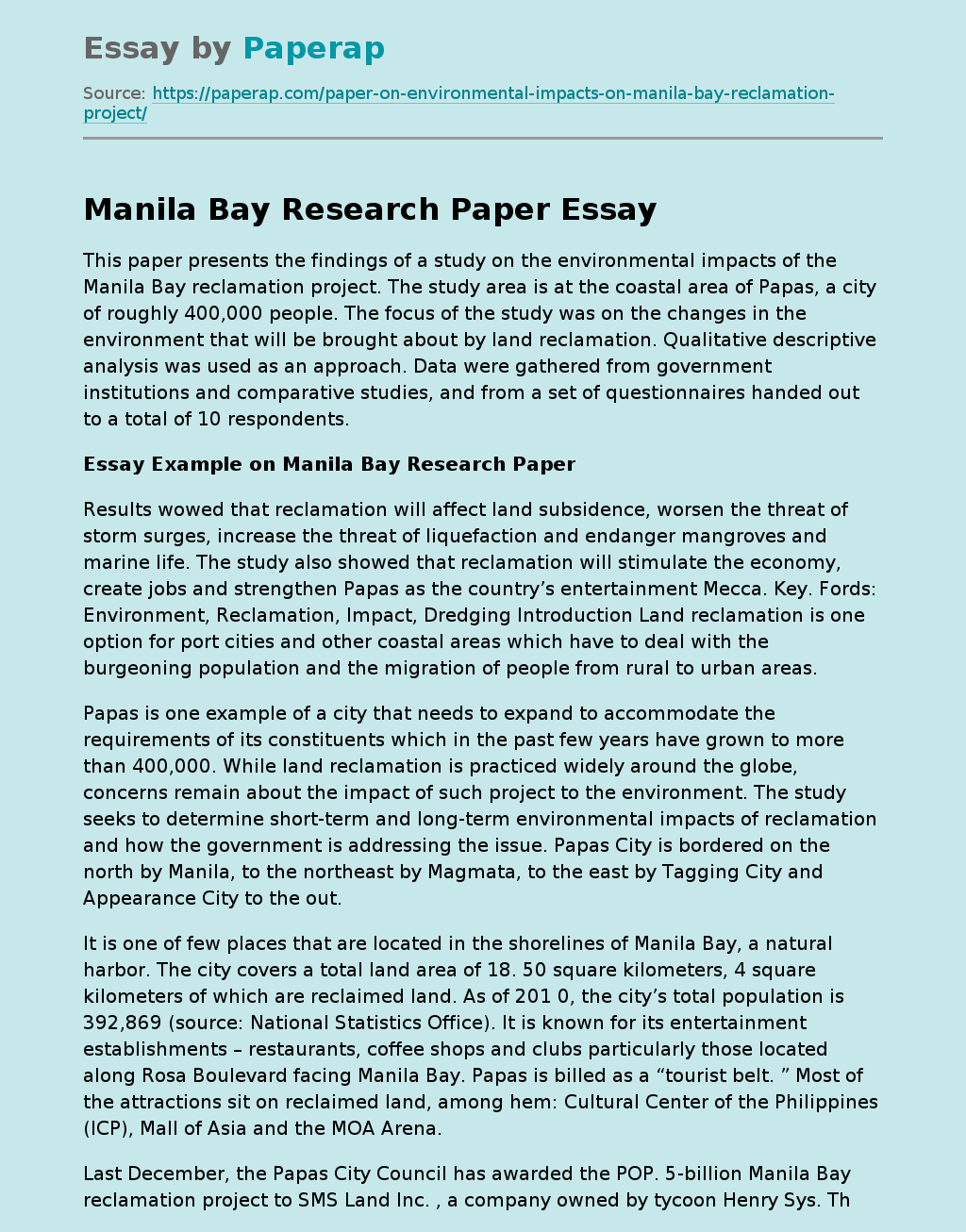Manila Bay Research Paper
This paper presents the findings of a study on the environmental impacts of the Manila Bay reclamation project. The study area is at the coastal area of Papas, a city of roughly 400,000 people. The focus of the study was on the changes in the environment that will be brought about by land reclamation. Qualitative descriptive analysis was used as an approach. Data were gathered from government institutions and comparative studies, and from a set of questionnaires handed out to a total of 10 respondents.
Essay Example on Manila Bay Research Paper
Results wowed that reclamation will affect land subsidence, worsen the threat of storm surges, increase the threat of liquefaction and endanger mangroves and marine life. The study also showed that reclamation will stimulate the economy, create jobs and strengthen Papas as the country’s entertainment Mecca. Key. Fords: Environment, Reclamation, Impact, Dredging Introduction Land reclamation is one option for port cities and other coastal areas which have to deal with the burgeoning population and the migration of people from rural to urban areas.
Papas is one example of a city that needs to expand to accommodate the requirements of its constituents which in the past few years have grown to more than 400,000. While land reclamation is practiced widely around the globe, concerns remain about the impact of such project to the environment. The study seeks to determine short-term and long-term environmental impacts of reclamation and how the government is addressing the issue. Papas City is bordered on the north by Manila, to the northeast by Magmata, to the east by Tagging City and Appearance City to the out.
It is one of few places that are located in the shorelines of Manila Bay, a natural harbor. The city covers a total land area of 18. 50 square kilometers, 4 square kilometers of which are reclaimed land. As of 201 0, the city’s total population is 392,869 (source: National Statistics Office). It is known for its entertainment establishments – restaurants, coffee shops and clubs particularly those located along Rosa Boulevard facing Manila Bay. Papas is billed as a “tourist belt. ” Most of the attractions sit on reclaimed land, among hem: Cultural Center of the Philippines (ICP), Mall of Asia and the MOA Arena.
Last December, the Papas City Council has awarded the POP. 5-billion Manila Bay reclamation project to SMS Land Inc. , a company owned by tycoon Henry Sys. The plan involves reclaiming around 300 hectares in the foreshore and onshore areas of Manila Bay at the western part of the jurisdiction of Papas City. While the project promises to boost the local economy through revenues and job generation, Papas still has to pay attention to the adverse environmental impacts that it could cause.
In his 1 995 study, entitled “The Concept of Environmental Sustainability,” Robert Goodling said development should consider three factors: environmental sustainability, economic sustainability and social sustainability. The study will focus solely on the environment, the prime reason why the reclamation project is being opposed by the Church and environmental groups. It will weigh the positive and negative impacts of reclamation and recommend a course of action for the government. Method The method used in this study is descriptive and centers in Papas with a population of close to 400,000.
Experts were interviewed and asked how reclamation affects the environment. Interviews were conducted with experts who were asked about the possible effects of land reclamation. Will reclamation Worsen the perennial flood problems of the city? Will it speed up land subsidence? Will it increase the danger of storm surges and liquefaction? Will it endanger mangroves and marine life? The study also sought the sentiments of local officials and residents through a list of questions.
Manila Bay Research Paper. (2019, Nov 27). Retrieved from https://paperap.com/paper-on-environmental-impacts-on-manila-bay-reclamation-project/

